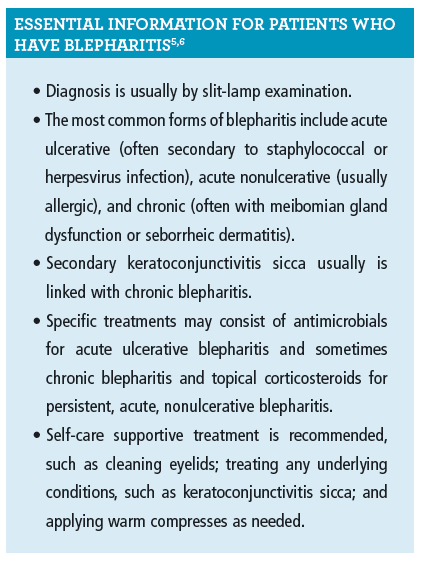Publication
Article
Pharmacy Times
Educate Patients About the Basics of Blepharitis
Author(s):
Pharmacists are in a prime position to convey preventive and treatment options for eyelid inflammation.
Blepharitis is an ophthalmic condition characterized by eyelid inflammation, which can be acute or chronic.
The common ocular condition accounts for an expanding percentage of primary care medical visits.1 Although blepharitis does not typically result in blindness, left intreated, it has can cause corneal neovascularization and ulceration, keratopathy, and permanent alterations in eyelid morphology.2 The pathophysiology is thought to stem from a bacterial infection, dermatologic conditions such as rosacea and seborrheic dermatitis, or a problem with the oil glands near the base of the eyelids.3 Common clinical presentation includes burning and/or itching of the eyelid margins and/or conjunctival irritation with lacrimation, photosensitivity, or the sensation of a foreign body.2,3
Blepharitis is classified into 2 types, according to the American Optometric Association.2 Anterior blepharitis affects the outside front of the eyelid, where the eyelashes are attached. The 2 most common causes of anterior blepharitis are bacteria (Staphylococcus) and scalp dandruff.2 Posterior blepharitis affects the inner eyelid and is caused by problems with the oil (meibomian) glands in this area. Two dermatologic disorders can cause this form of blepharitis: acne rosacea, which leads to erythema, and seborrheic dermatitis.2
Self-treatable ophthalmic disorders primarily affect the eyelids, but it is important that patients always seek medical guidance to determine if an infection is present and rule out a more complicated condition or disorder.4 Pharmacists can assess if self-treatment is appropriate, direct patients to seek further medical care when warranted, and provide information about blepharitis. They can also educate patients about eyelid hygiene, including related nonprescription products, and the numerous OTC artificial tear products that may provide symptomatic relief.
PRACTICING PROPER EYELID HYGIENE
Even with successful treatment, blepharitis may recur. Treatment depends on the severity and type of blepharitis, and some cases require more complex regimens. Blepharitis rarely disappears completely.5,6 Proper eyelid hygiene is the foundation of treatment and is effective in most cases.3
For a bacterial infection that does not respond to eyelid hygiene, a prescription topical antibiotic ointment may be warranted.5 A severe case may call for an oral antibiotic and a short course of a steroid.3,5 Because most blepharitis cases are chronic, patients need to follow a good hygiene regimen to prevent recurrence. Recommended measures include:2,3,5
- Adhere to prescribed therapy that may include antibiotic, antiviral, or steroid medications, depending on the severity and type of blepharitis.
- Apply a warm, wet compress to the eye for 5 to 10 minutes to dilate the meibomian glands and soften eyelid debris and oils.
- Gently scrub the eyelids with a mixture of a nonirritating shampoo and water or an OTC lid cleanser.
- Massage the eyelid margins to express oils from the meibomian glands.
- Perform eyelid hygiene 2 to 4 times a day during symptomatic exacerbations of blepharitis.
- Limit or stop the use of eye makeup to make practicing good hygiene easier.
- Temporarily discontinue wearing contact lenses during treatment.
- Use artificial lubricating ointments or tear solutions if recommended by an eye specialist.
- Maintain a lid-hygiene regimen for chronic blepharitis to avoid recurrence of irritating symptoms.
PREVENTING COMPLICATIONS
As frontline health care providers, pharmacists can educate patients about recommended preventive measures and self-care for blepharitis. They can also encourage and remind patients to consult with eye care professionals to confirm diagnosis and for recurring and severe episodes, including those that show signs of infection, to get further treatment to avoid complications.

PATIENT EDUCATION RESOURCES
American Academy of Ophthalmology: aao.org/eye-health/diseases/ what-is-blepharitis
Mayo Clinic: mayoclinic.org/diseases-conditions/blepharitis/symptoms- causes/syc-20370141
National Eye Institute: nei.nih.gov/learn-about-eye-health/eye-conditions- and-diseases/blepharitis
Yvette C. Terrie, BSPharm, RPh, is a consulting pharmacist and a medical writer in Haymarket, Virginia.
REFERENCES
- Putnam CM. Diagnosis and management of blepharitis: an optometrist’s perspective. Clin Optom. 2016;8:71-78. doi:10.2147/OPTO.S84795
- Blepharitis. American Optometric Association. Accessed March 10. 2020. https://www. aoa.org/patients-and-public/eye-and-vision-problems/glossary-of-eye-and-vision-conditions/ blepharitis
- Eberhardt M, Rammohan G. Blepharitis. National Center for Biotechnology Information. Updated September 8, 2019. Accessed March 10, 2020. https://www.ncbi.nlm.nih.gov/books/ NBK459305/
- Fiscella R, Jensen M. Ophthalmic disorders. In: Krinsky DL, Ferreri SP, Hemstreet B, et al, eds. Handbook of Nonprescription Drugs: An Interactive Approach to Self-Care. 19th ed. American Pharmacists Association; 2017:217-230.
- Garrity J. Blepharitis. Merck Manuals. Updated May 2019. Accessed March 10, 2020. https:// www.merckmanuals.com/professional/eye-disorders/eyelid-and-lacrimal-disorders/blepharitis
- Blepharitis. National Eye Institute. Updated July 2, 2019. Accessed March 11, 2020. https:// www.nei.nih.gov/learn-about-eye-health/eye-conditions-and-diseases/blepharitis







